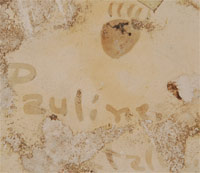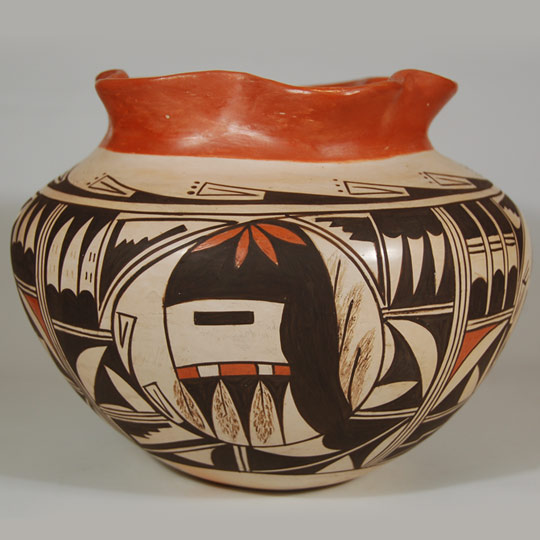Adobe Gallery Blog
Subject: Hopi Large Polychrome Storage Jar with Fluted Rim
 Pauline Setalla was born and raised on the Second Mesa village of Mishongnovi. When she married Justin Setalla they moved to his ranch in Snowbird Canyon which is approximately 3 miles from Keams Canyon on the reservation. Their home was a traditional Hopi adobe home that had been built by Justin and his dad Roscoe. It had no modern conveniences of today's standards. Light was provided by kerosene and Coleman lantern and heat by wood and coal in a stove. Drinking water had to be hauled from the family well. Under these conditions, Pauline Setalla mastered the techniques of pottery production.
Pauline Setalla was born and raised on the Second Mesa village of Mishongnovi. When she married Justin Setalla they moved to his ranch in Snowbird Canyon which is approximately 3 miles from Keams Canyon on the reservation. Their home was a traditional Hopi adobe home that had been built by Justin and his dad Roscoe. It had no modern conveniences of today's standards. Light was provided by kerosene and Coleman lantern and heat by wood and coal in a stove. Drinking water had to be hauled from the family well. Under these conditions, Pauline Setalla mastered the techniques of pottery production.
Her pottery is noted for its strong, bold designs, excellent painting quality, stippled shading and beautiful clay that fires in warm shades from yellow to orange. Her forms are well balanced and elegant in shape. The symmetry reflects technical skill and confidence. Her designs are bolder than often seen on Hopi pottery by other potters. Her work is immediately recognizable.
The large storage jar is typical of her outstanding workmanship. It is beautifully proportioned and skillfully constructed. The rim rolls out in undulating ripples which the potter accented by painting it a rusty red. The body design includes the face of a Long Hair Katsina and ears of corn. To the Hopi, corn is not only the traditional staff of life but also the symbol of spiritual food and welfare.
This jar is a perfect complement to a pair of large cylinder jar made by Setalla at the same time. The three pieces have been together for about 40 or 50 years and deserved to continue their relationship, however, we must, of course, sell them separately if that is the desire of the purchaser.
Condition: structurally in original condition with some minor over-paint on brown color.
Provenance: from the collection of Katherine H. Rust whose collection was mostly amassed in the 1960s and 1970s so it is assumed that is the approximate period that these were made.
Recommended Reading: Hopi-Tewa Pottery: 500 Artist Biographies by Gregory and Angie Schaaf
Subject: Hopi Large Polychrome Storage Jar with Fluted Rim
Artist / Potter: Pauline Setalla (1930-?)
Category: Contemporary
Origin: Hopi Pueblo
Medium: clay, pigment
Size: 9-3/8" tall x 12-1/4" diameter
Item # C3309K


